 Applied Mathematics, 2011, 2, 824-829 doi:10.4236/am.2011.27110 Published Online July 2011 (http://www.SciRP.org/journal/am) Copyright © 2011 SciRes. AM Bivariate Zero-Inflated Power Series Distribution Patil Maruti Krishna1, Shirke Digambar Tukaram2 1Department of Stat i s t i c s, P. V. P. Mahavidyalaya, Kavathe Mahankal, Sangli, India 2Department of Stat i s t i c s, Shivaji University, Kol h apur, India E-mail: mkpatil_stats@rediffmail.com, dtshirke@gm ai l.com Received December 19, 2010; revised May 12, 2011; accepted M ay 15, 2011 Abstract Many researchers have discussed zero-inflated univariate distributions. These univariate models are not suitable, for modeling events that involve different types of counts or defects. To model several types of de- fects, multivariate Poisson model is one of the appropriate models. This can further be modified to incorpo- rate inflation at zero and we can have multivariate zero-inflated Poisson distribution. In the present article, we introduce a new Bivariate Zero Inflated Power Series Distribution and discuss inference related to the parameters involved in the model. We also discuss the inference related to Bivariate Zero Inflated Poisson Distribution. The model has been applied to a real life data. Extension to k-variate zero inflated power series distribution is also discussed. Keywords: Bivariate Zero-Inflated Power Series Distribution, Bivariate Zero-Inflated Poisson Distribution, K-Variate Zero-Inflated Power Series Distribution 1. Introduction In a manufacturing process there may exist several types of (say m) defects—for example, solder short circuits, solder voids, absence of solder etc. on one printed circuit board. These defects cause different types of product failure and generate different types of equipment prob- lems. In the above example there can be only one type of defect which occurs more frequently and the other de- fects occurs very rarely. Another situation could be both types of defects occur rarely and so on. To model several types of defects, multivariate Poisson model is one of the appropriate models to use. This can further be modified to incorporate inflation at zero and we can have multi- variate zero-inflated Poisson (MZIP) distribution. There are several ways to construct MZIP distributions. In the literature, Chin-Shang et al. [1] have discussed various types of MZIP models and investigated their distribu- tional properties. Deshmukh and Kasture [2] have stud- ied bivariate distribution with truncated Poisson marginal distributions. Gupta et al. [3] have considered inflated distributions at the point zero and studied the structural properties of the inflated distribution. Gupta et al. [4] have discussed score test for zero-inflated generalized Poisson regression model. Holgate [5] described the es- timation of covariance parameter of bivariate Poisson distribution by iterative method. Lambert [6] considered zero-inflated Poisson regression model. Laxminarayana et al. [7] have studied bivariate Poisson distribution and the distributional properties of the model. Patil and Shirke [8] studied testing parameter of the power series distribution of a zero-inflated power series model. Patil and Shirke [9] also studied equality of inflation parame- ters of two zero-inflated power series distributions. It appears that majority of the study in the literature is re- stricted to Poisson distribution and its extension to mul- tivariate set up. Relatively less has been reported for the family of distributions containing other distributions. In this article, we introduce a new Bivariate Zero-In- flated Power Series Distribution (BZIPSD) and discuss inference related to the parameters involved in the same. The rest of the paper is organized as follows. Section 2, introduces the BZIPSD along with moments of the same. Section 3, deals with inference related to the parameters involved in the BZIPSD. In Section 4, we discuss infer- ence related to Bivariate Zero-Inflated Poisson Distribu- tion (BZIPD). The data set reported by Arbous and Ker- rich [10] is modeled by Bivariate Zero Inflated Poisson Distribution. The paper concludes with generalization to multivariate setup. 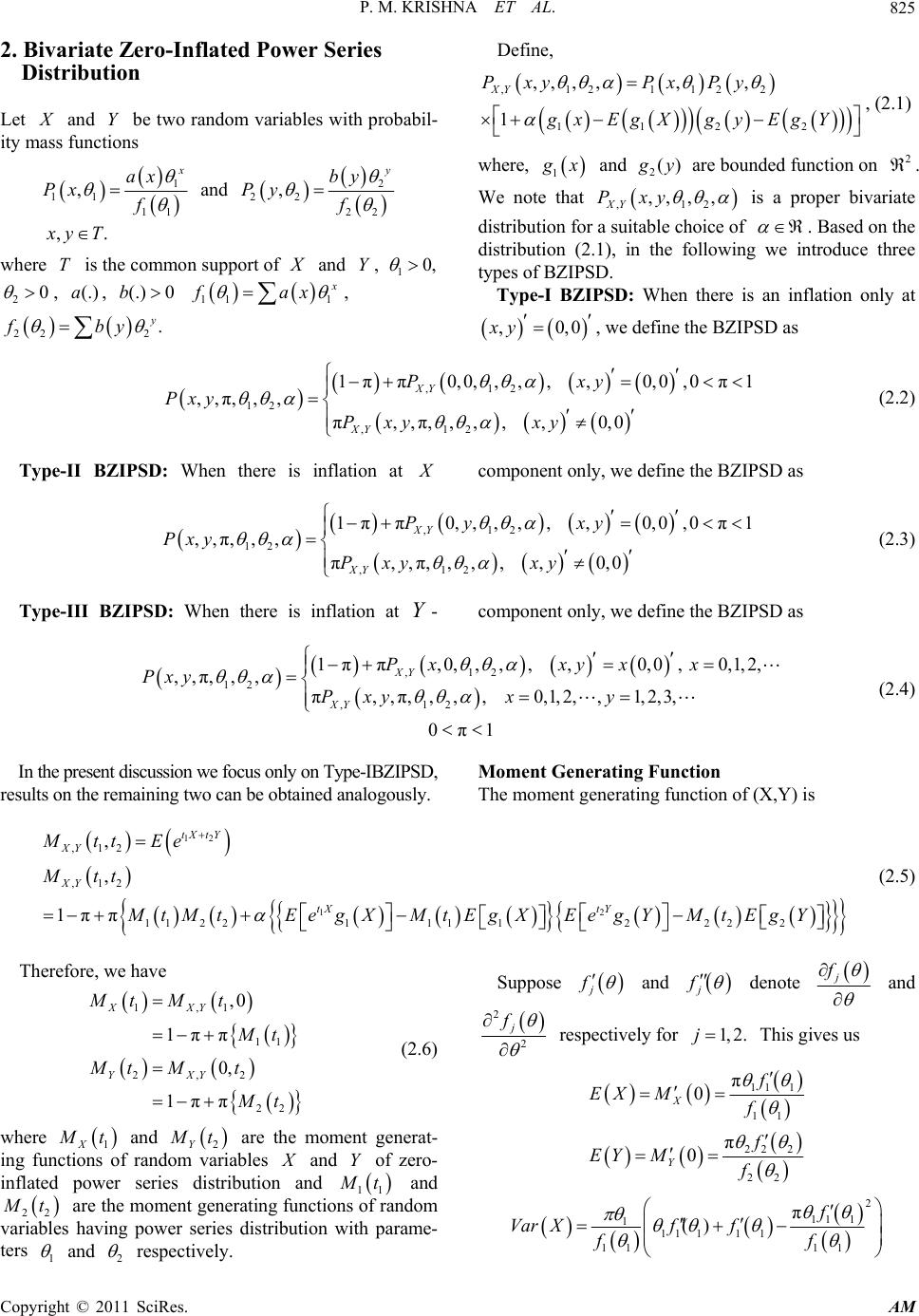 P. M. KRISHNA ET AL.825 2. Bivariate Zero-Inflated Power Series Distribution Let and Y be two random variables with probabil- ity mass functions 1 11 11 , ax Px f and 2 22 22 , by Py f ,. yT where is the common support of T and Y, 10, 20 , , (.)a(.) 0b 11 1 fax , 22 2 . fby Define, ,121122 112 2 ,, ,,,, 1 XY Pxy PxPy gx EgXgy EgY , (2.1) where, 1 x and 2() y are bounded function on 2 . note that We 12 , , , , XY Pxy, is a proper bivariate distribution for a suitable choice of . Based on the distribution (2.1), in the followingntroduce three types of BZIPSD. Type-I BZIPSD we i : When there is an inflation only at x ,0,0y , we define the BZIPSD as ,12 12 ,12 1ππ 0, 0,,,,,0, 0, 0π1 ,,π,, , π,,π,, ,,,0,0 XY XY Pxy Pxy Pxy xy (2.2) Type-II BZIPSD: When there is inflation at component only, we define the BZIPSD as (2.3) Type-III BZIPSD: When there is inflation at component only, we define the BZIPSD as (2.4) In the present discussion we focus only on Type-IBZIPSD, re Moment Generating Function of (X,Y) is ,12 12 ,12 1ππ 0,,,,,,0,0,0π1 ,,π,, , π,,π,,, ,,0,0 XY XY Py xy Pxy Pxyxy Y- ,12 12 ,12 1ππ ,0,,,,,0,0, 0,1,2, ,,π,,, π,,π,,,,0,1, 2,,1, 2, 3, 0π1 XY XY Pxxy xx Pxy Pxyx y sults on the remaining two can be obtained analogously. The moment generating function 12 12 ,12 ,12 1122111122 22 , , 1ππ tX tY XY XY tX tY MttEe Mtt MtMtEegX MtEgXEegY MtEgY (2.5) Therefore, we have Mt M 1,1 11 2,2 22 ,0 1ππ 0, 1ππ XXY YXY t t Mt Mt t (2.6) where 1X t j f and j f j f denote and 2Y t m vari are the moment generat- ing funf randoables ctions o and Y of zero- inflated power series distributionnd a 11 t and 22 t are the moment generating functions dom s having power series distribution with parame- ters 1 of ran variable and 2 respectively. Suose pp and 2 2 j f ives us respectively for This g 1, 2j. 11 1 1 f EX Mf1 π 0 X 22 2 22 π 0 Y f EY Mf 2 111 1 11 111 11 11 π () f Var Xff ff Copyright © 2011 SciRes. AM 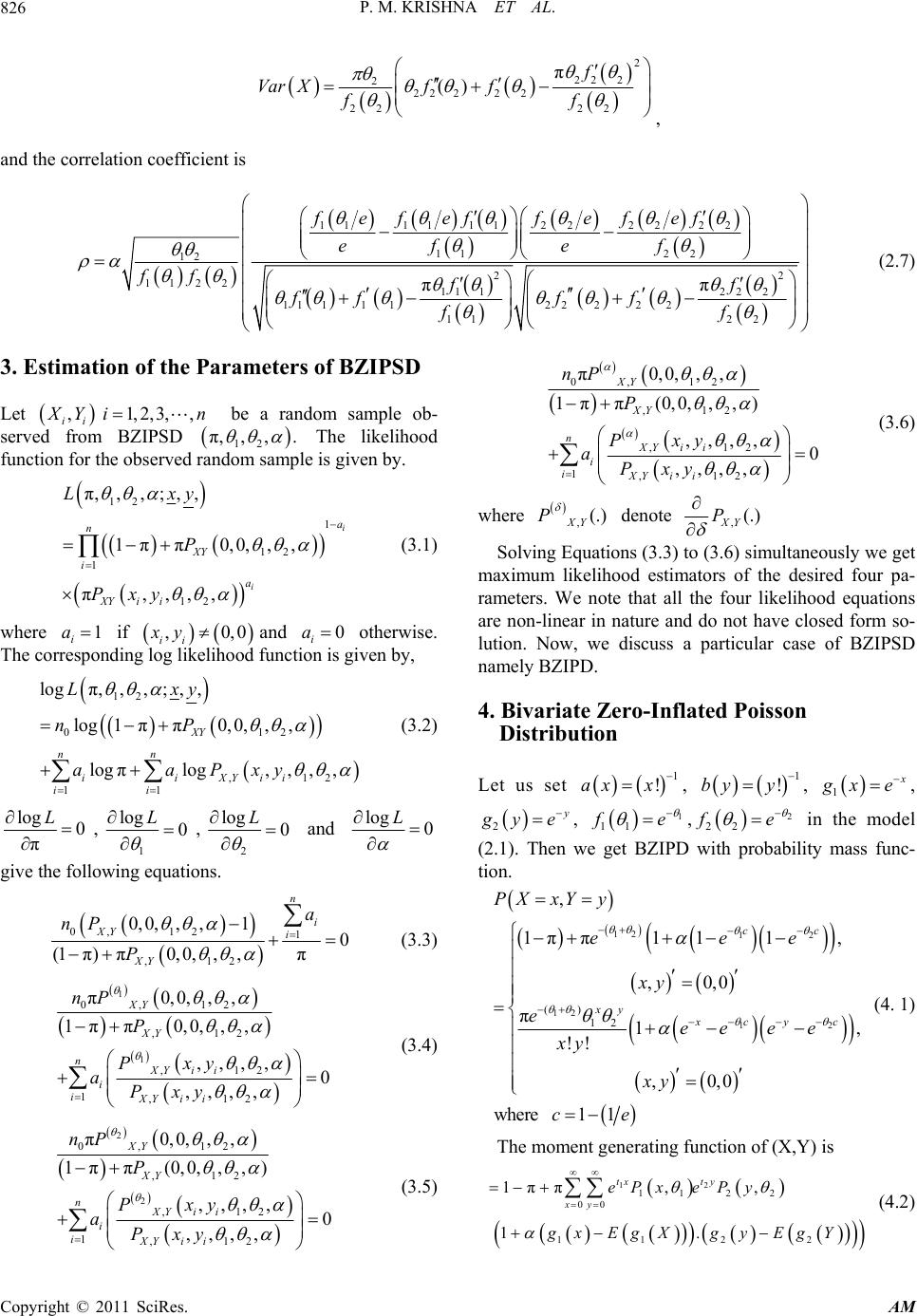 P. M. KRISHNA ET AL. 826 2 22 2 2 22 222 22 22 π () f Var Xff ff , and the correlation coefficient is 1111 11222222 112 2 12 22 11 2 21112 22 111112 2222 112 2 ππ fefeff efef efe f ff ff ffff ff (2.7) 3. Estimation of the Parameters of BZIPSD Let , ,1,2,3, ii Yi n be a random sample ob- served from BZIPSD 12 π,,, . The likelihood functe is given by. ion for the observed random sampl 12 1 π,,,;,, i a n Lxy (3 12 1 12 1ππ 0, 0, ,, π,,,, i XY i a XY i i P Px y .1) where if 0 and otherwise. The codinunctven by, 1 i a rrespon ,0, ii xy g log likelihood f 0 i a ion is gi 12 012 lo , log 1 ππ 0,0,,, XY nP ,1 2 11 gπ, ,;,, log πlog, , ,, nn ii XYii ii Lxy aaPxy ) (3.2 log 0 π L , 1 log 0 L , 2 log 0 L and log 0 L give the following equations. 0, 12 0, 0,,, (1 π)π0, 0,, XY a nP P 1 ,1 2 10 ,π n i i XY (3.3) 1 1 0, 12 ,12 ,12 1,12 π0, 0,,, 1ππ 0, 0,,, ,,,, 0 ,,,, XY XY nXYi i i iXYi i nP P Pxy aPxy (3.4) 2 2 0, 12 ,12 ,12 1,12 π0, 0,,, 1ππ (0,0,,, ) ,,,, 0 ,,,, XY XY nXYi i i iXYi i nP P Pxy aPxy 0, 12 ,12 ,12 1,12 π0, 0,,, 1ππ (0,0,,, ) ,,,, 0 ,,,, XY XY nXYi i i iXYi i nP P Pxy aPxy (3.6) where denote ,(.) XY P ,(.) XY P Solving Equations (3.3) to (3.6) simultaneously we get maximum likelihood estimators of the desired four pa- rameters. We note that all the four likelihood equations are non-linear in nature and do not have clo lution. Now, we discuss a particular case namely BZIPD. sed form so- of BZIPSD 4. Bivariate Zero-Inflated Poisson Distribution Let us set 1 !ax x , 1 !by y , 1 xe , 2 ye , 1 11 fe , 2 22 fe in the model (2.1). Then we get BZIPD with probability mass func- tion. (3.5) 12 1 12 , , ,0,0 π1, ,0,0 where 11 xy c xy 12 12 1ππ 111 cc 2 () c !! XxYy xy eee e xy ce ee e e xy (4. 1 The moment generating function of (X,Y) is (4.2) ) 12 1122 00 112 2 1ππ ,, 1. txt y xy ePxePy gxEgXgyEgY Copyright © 2011 SciRes. AM 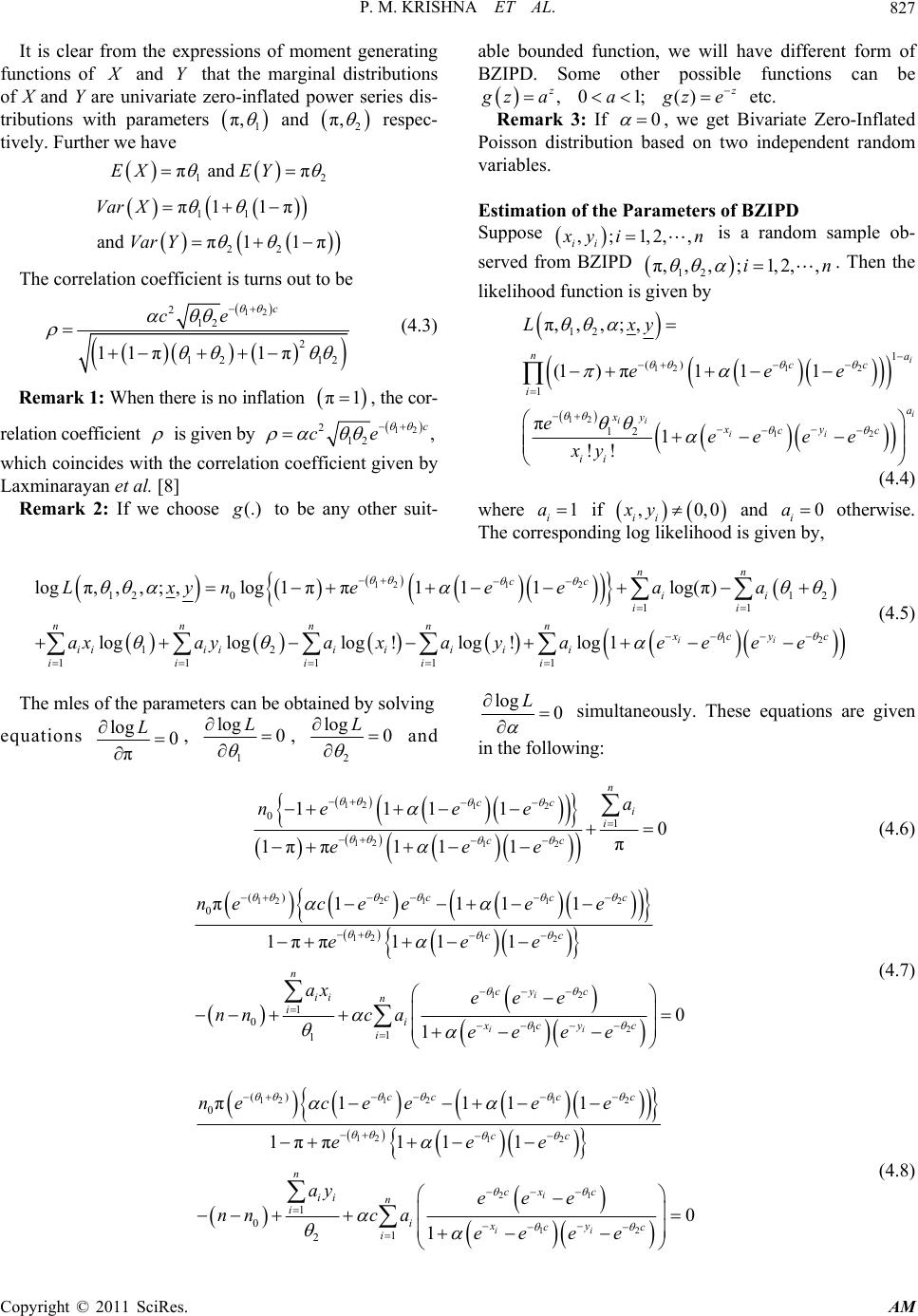 P. M. KRISHNA ET AL.827 It is clear from the expressions of moment generating functions of and that the marginal distributions of X and Y are univariate zero-inflated power series dis- tributions with paramters Y e 1 π, and 2 π, respec- tively. Further we have 12 π and πEX EY 11 22 π11π and π11π Var X Var Y The correlation coefficient is turns out to be 12 2c 12 2 12 12 11π1π ce (4.3) Remark 1: When there is no inflation , the cor- π1 relation coefficient is given by 12 2 12 c ce , which coincides with the correlation coefficient given by Laxminarayan et al. [8] Remark 2: If we choose (.) to be anher suit- able bounded function, we will have different form of BZIPD. Some other possible functions can be , za 01a; () ze 0 etc. Remark 3: If , we get Bivariate Zero-Inflated Poisson distribution based on two independent random variables. Estimation of the Parameters of BZIPD Suppose ,;1,2,, ii yi n is a random sample ob- served from BZIPD ,;1,2, ,i 12 π,, n . Then the likelihood function is given by 121 2 12 12 12 1 () 1 12 π,,,;, (1) π111 π1 !! i i ii ii na cc i a xy xy cc ii Lxy eee eee ee xy (4.4) where 1 i a if ,0, ii xy y ot 0 and otherwise. The corresponding log likelihood is given by, 0 i a 12 11 1 loglog log ii ii i ii i ax ay a 12 12 12 12 012 11 11 log π,, ,;,log1ππ 11 1log(π) !log!log 1ii nn cc ii ii nnnnn xy cc ii ii ii Lxyn eeaa xayae eee (4.5) The mles of the parameters can be obtained equations e by solving and log 0 L in the followi simultaneously. These equations are given ng: log 0 π L , 12 log 0 L log 0 L , 12 12 12 1ππ 11e 12 01 11 1 0 π 1 n cc i i cc a e ee 1ne e (4.6) 122 112 12 12 12 12 () 0 1 0 1 1i π11 11 1ππ 11 1 0 1 i ii c c cc n y cc ii n iixy cc nec eeee eee ax eee nnc aeeee cc (4.7) 121 21 11 c e e 2 12 12 21 12 () 0 1 0 1 2 π11 1ππ 11 1 0 1 i ii cc c cc n x cc ii n iixy cc i nec ee eee ay eee nnc aee ee (4.8) Copyright © 2011 SciRes. AM 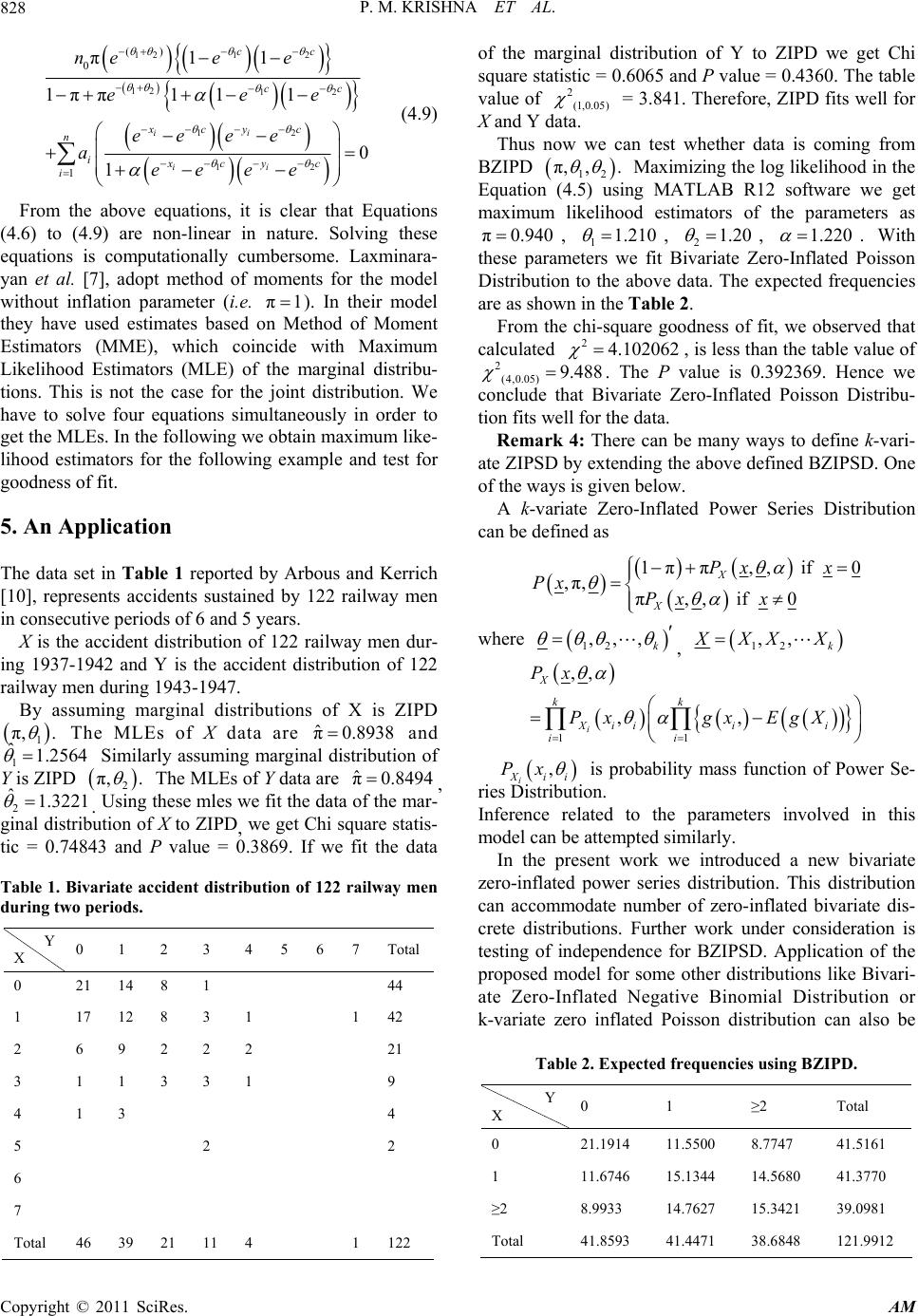 P. M. KRISHNA ET AL. 828 1212 12 12 12 12 () 0 1 π11 1ππ 111 0 1 ii ii cc cc xy cc n ixy cc i nee e eee ee ee aee ee of the marginal distribution of Y to ZIPD we get Chi square statistic = 0.6065 and P value = 0.4360. The table value of = 3.841. Therefore, ZIPD fits well for X and Y dat Thus now we can test whet BZIPD (4.9) From the above equations, it is clear that Equations (4.6) to (4.9) are non-linear in nature. Solving these equations is computationally cumbersome. Laxminara- yan et al. [7], adopt method of moments for the model without inflation parameter (i.e. ). In their model they have used estimates based on Method of Moment Estimators (MME), which coincide with Maximum Likelihood Estimators (MLE) of the marginal distribu- tions. This is not the case for the joint distribution. We have to solve four equations simultaneously in order to et the MLEs. In the following we obtain maximum like- lihood estimators for the following example and test for goodness of fit. 5. An Application The data set in Table 1 reported by Arbous and Kerrich [10], π1 g represents accidents sustained by 122 railway men in consecutive periods of 6 and 5 years. X is the accident distribution of 122 railway men dur- ing 1937-1942 and Y is the accident distribution of 122 railway men during 1943-1947. By assuming marginal distributions of X is ZIPD 1 π,. The MLEs of X data are ˆ π0.8938 and 1 ˆ1.2564 Similarly assuming marginal distribution of Y is ZIPD 2 π,. The MLEs of Y data are ˆ π0.8494 , 2 ˆ1.3221 . Using these mles we fit the data of the mar- ginal distribution of X to ZIPD, we get Chi square statis- tic = 0.74843 and P value = 0.3869. If we fit the data Table 1. Bivariate accident distribution of 122 railway men 0 1 2 3 4 5 6 7 Total during two periods. Y X 0 21 14 8 1 44 1 17 12 8 3 1 1 42 9 5 2 6 9 2 2 2 21 3 1 1 3 3 1 4 1 3 4 2 2 6 7 Total 46 39 21 11 4 1 122 2 (1,0.05) a. her data is coming from 12 π,, . n (4.5) using m likeliho 0 Maximizing the log likelihood in the Equatio MATLAB R12 software we get maximuod estimators of the parameters as π0.94 , 11.210 , 21.20 , 1.22 0 -Inflated . With ZeroPoisson Distribution to the above data. The expected frequencies are as shown in the Table 2. From the chi-square good calculated , is less than the table value of alue is 0.392369. Hence we o-Inflated Poisson Distribu- tion fits well for the data. Remark 4: There can be mny ways to define k-vari- A k-variate Zero-Inflated Power Series Distribution cabeed these parameters we fit Bivariate ness of fit, we observed that 24.102062 9.488 . The P v hat Bivariate Zer 2 (4,0.05) conclude t a ate ZIPSD by extending the above defined BZIPSD. One of the ways is given below. n e dfinas 1ππ ,,f 0 ,,f X Px Px i ,π πP,x i x0 Xx where 12 ,,, k , 12 ,, k XX X ,, ,, i X Xii Px Pxg EgX i 11i kk ii x , i Xii Px ries Distriuti is probability ma fucti ofowr Se- o Inted to parameters involved in man apsiarly. modat ons. Further work under consideration is te model fo ≥2 Total ssnon Pe b n. ference odel c rela be the ted this ttem mil In the present work we introduced a new bivariate zero-inflated power series distribution. This distribution can accome number of zero-inflated bivariate dis- crete distributi sting of independence for BZIPSD. Application of the proposedr some other distributions like Bivari- ate Zero-Inflated Negative Binomial Distribution or k-variate zero inflated Poisson distribution can also be Table 2. Expected frequencie s using BZIPD. Y X0 1 0 5500 8.7747 41.5161 21.1914 11. 1 11.6746 15.1344 14.5680 41.3770 ≥2 8.9933 14.7627 15.3421 39.0981 Total 41.8593 41.4471 38.6848 121.9912 Copyright © 2011 SciRes. AM 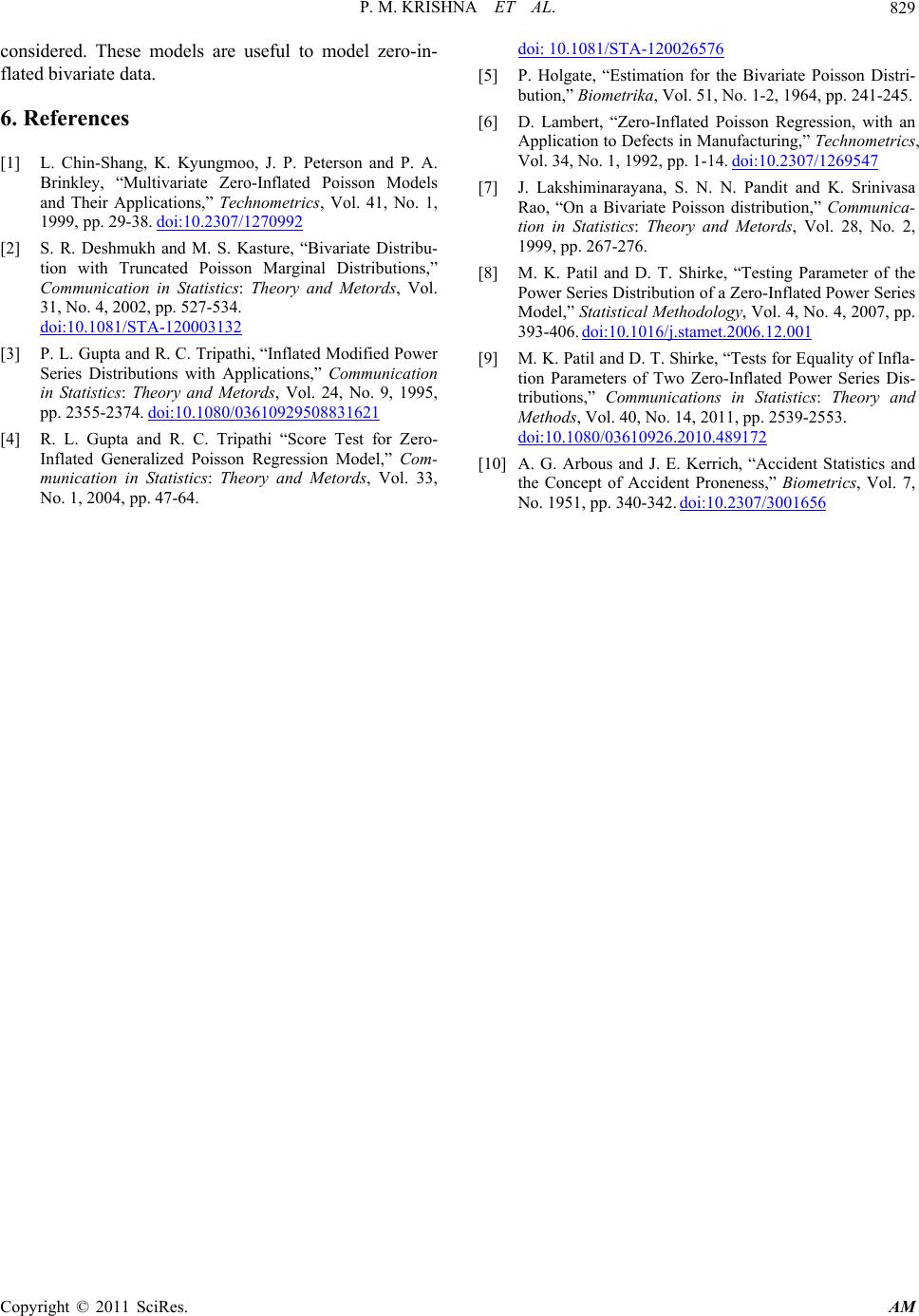 P. M. KRISHNA ET AL.829 [1] L. Chin-Shang, K. Kyungmoo, J. P. Peterson and P. A. Brinkley, “Multivariate Zero-Inflated Poisson and Their Applications,” Technometrics, Vol. 41, No. 1, 99, pp. 29-38. doi:10.2307/1270992 doi: 10.1081/STA-120026576 considered. These models are useful to model zero-in- flated bivariate data. [5] P. Holgate, “Estimation for the Bivariate Poisson Distri- 307/1269547 6. References Models 19 [2] S. R. Deshmukh and M. S. Kasture, “Bivariat tion with Truncated Poisson Marginal Distributions,” Communication in Statistics: Theory and Metord 31, No. 4, 2002, pp. 527-534. doi:10.1081/STA-120003132 e Distribu- s, Vol. [3] P. L. Gupta and R. C. Tripathi, “Inflated Modified Power Series Distributions with Applications,” Communication in Statistics: Theory and Metords, Vol. 24, No. 9, 1995, pp. 2355-2374. doi:10.1080/03610929508831621 [4] R. L. Gupta and R. C. Tripathi “Score Test for Zero- Inflated Generalized Poisson Regression Model,” Com- munication in Statistics: Theory and Metords, Vol. 33, No. 1, 2004, pp. 47-64. bution,” Biometrika, Vol. 51, No. 1-2, 1964, pp. 241-245. [6] D. Lambert, “Zero-Inflated Poisson Regression, with an Application to Defects in Manufacturing,” Technometrics, Vol. 34, No. 1, 1992, pp. 1-14. doi:10.2 [7] J. Lakshiminarayana, S. N. N. Pandit and K. Srinivasa Rao, “On a Bivariate Poisson distribution,” Communica- tion in Statistics: Theory and Metords, Vol. 28, No. 2, 1999, pp. 267-276. [8] M. K. Patil and D. T. Shirke, “Testing Parameter of the Power Series Distribution of a Zero-Inflated Power Series Model,” Statistical Methodology, Vol. 4, No. 4, 2007, pp. 393-406. doi:10.1016/j.stamet.2006.12.001 [9] M. K. Patil and D. T. Shirke, “Tests for Equality of Infla- tion Parameters of Two Zero-Inflated Power Series Dis- tributions,” Communications in Statistics: Theory and Methods, Vol. 40, No. 14, 2011, pp. 2539-2553. doi:10.1080/03610926.2010.489172 [10] A. G. Arbous and J. E. Kerrich, “Accident Statistics and the Concept of Accident Proneness,” Biometrics, Vol. 7, No. 1951, pp. 340-342. doi:10.2307/3001656 Copyright © 2011 SciRes. AM
|